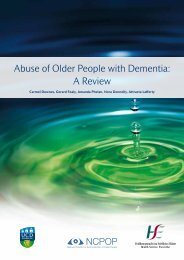Public Perceptions of Older People A literature review
Review 1 PP OP.pdf - National Centre for the Protection of Older ...
Review 1 PP OP.pdf - National Centre for the Protection of Older ...
You also want an ePaper? Increase the reach of your titles
YUMPU automatically turns print PDFs into web optimized ePapers that Google loves.
Towards Old <strong>People</strong> Scale (Kogan 1961), The Ageing Semantic Differential<br />
Scale (Rosencranz & McNevin 1969), and Palmore’s Facts on Ageing Quizzes<br />
(Palmore 1977, 1981).<br />
7.4 Mixed perceptions <strong>of</strong> older people and ageing<br />
A substantial body <strong>of</strong> <strong>literature</strong> exists which examines age-related perceptions<br />
not least in relation to perceptions <strong>of</strong> older people (Gellis et al. 2003). Overall,<br />
previous research in this field has tended to draw on and then compare and<br />
contrast the perceptions towards older people within different societal groups,<br />
such as children and students. Research into public perceptions <strong>of</strong> older<br />
people and ageing has traditionally been based on the assumption that<br />
negative attitudes are widespread (Butler 1969) with numerous studies<br />
reporting negative views <strong>of</strong> older people and ageing (e.g. Kite et al. 2005;<br />
Arnold-Cathalifaud et al. 2008; Allan & Johnson 2009). Nosek et al. (2002)<br />
found that negative implicit attitudes towards older people relative to young<br />
people were, on average, the strongest <strong>of</strong> any obtained in their study,<br />
including attitudes toward race and gender stereotypes. Furthermore, many <strong>of</strong><br />
these more negative views tend to be reported by younger age groups (Kite<br />
et al. 2005; Woolf 2006; Cottle & Glover 2007). These negative views will be<br />
examined in greater detail throughout the paper.<br />
Despite the fact that Arnold-Cathalifaud et al. (2008) maintained that there<br />
are few exceptions to these negative responses to older people and ageing, a<br />
number <strong>of</strong> recent studies have reported overall positive or at least neutral<br />
attitudes. For example, Fernia and colleagues (2008) reported that from a<br />
small sample <strong>of</strong> children in the US, approximately 75% <strong>of</strong> 8-9 year old<br />
children gave either neutral or positive descriptions <strong>of</strong> older people. Similarly,<br />
in Taiwan, Yen et al. (2009) examined attitudes <strong>of</strong> nursing and medical<br />
students towards older people and found a tendency towards positive<br />
attitudes for this cohort. Consistent with these findings, Tan et al. (2004)<br />
studied Chinese university students’ perceptions <strong>of</strong> older people and found<br />
that overall, they also expressed positive or, at the very least, neutral<br />
attitudes toward older people. These findings concur with recent research<br />
conducted in other countries such as in the US, the UK and in Sweden (e.g.<br />
Soderhamn et al. 2001; Kaempfer et al. 2002; Cummings & Galambos 2003;<br />
Fitzgerald et al. 2003; Laditka et al. 2004; Moriello et al. 2005; Snyder 2005;<br />
Brown et al. 2008; Hughes et al. 2008; Narayan 2008; Voogt et al. 2008).<br />
Similarly, studies have also reported that older people have been perceived as<br />
11









